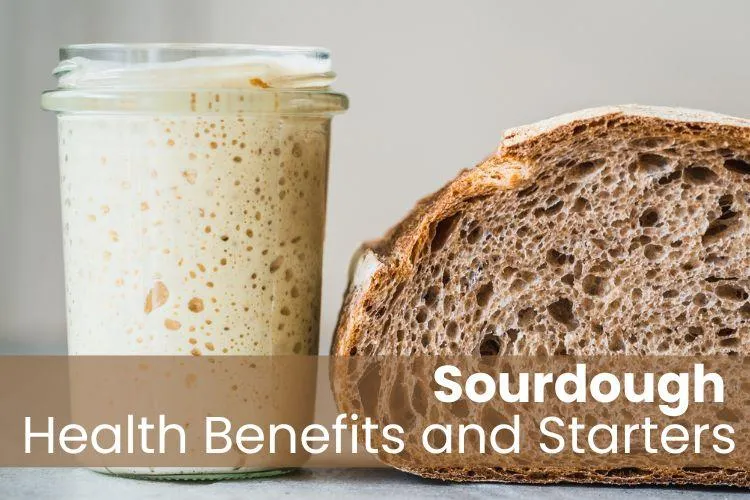
Sourdough: Health Benefits and Starters
Sourdough bread has been around for thousands of years. It is likely the earliest known method of leavening bread, long before commercial yeast was discovered. Over time, faster yeasts and quick-rise leavening agents replaced sourdough due to their shorter preparation times and greater predictability. But sourdough is making a comeback thanks to the many health benefits it offers.
Sourdough Has a Longer Shelf Life
With the ease of making yeast breads, we lost the natural shelf life that sourdough provides. Yeast breads require more preservatives to stay fresh longer, something many people would rather avoid. Sourdough, on the other hand, contains natural acids that act as preservatives, making it an appealing option for those who prefer a shorter, more natural ingredient list.
Sourdough Supports Gut Health
During fermentation, wild yeasts and lactic acid bacteria break down gluten, phytic acid, and minerals, making them easier to digest. Many people with sensitivities to gluten or wheat find they tolerate white or whole wheat sourdough better than conventional yeast breads. However, it’s important to distinguish between sensitivity and allergy. Those with a known allergy should avoid sourdough made from wheat or containing gluten.
Sourdough has a lower glycemic index (GI)
After eating a slice of sourdough bread, the rate of glucose being released into the bloodstream is slower, so blood sugar levels don’t peak as high. That said, be aware that honey, sugar, jams and other sweet toppings do not change their GI level simply because they are accompanying sourdough bread. If you’re watching carbohydrates or blood glucose levels, those additions still count.
What about the nutrient value of whole wheat sourdough versus white sourdough? Whole wheat sourdough is more nutrient dense than sourdough made from refined wheat, like all-purpose flour or organic white flour. Whole wheat retains higher levels of fiber and minerals. Although flavors can be different and subjective to individual preference, whole wheat is a healthier option.
If you think you want to learn about baking with sourdough, here are some key basics to
understand before getting started:
Starter Flavor Matters
Different starters produce different flavors due to various factors. To get an ideal flavor, some bakers seek out a starter from a unique source only to realize that, strangely, it changes over time. One major factor in this evolution is the type of flour used to feed it. Whole wheat flours contain more minerals and natural enzymes, which speed up fermentation. This causes breads made with whole wheat starter to rise faster and have a stronger acidic or sour flavor. They also give off a nuttier flavor. Depending on what you're baking, this might be an advantage.
I discovered this firsthand when a friend gifted me a fantastic sourdough starter along with her cinnamon roll recipe. My friend used organic, white, unbleached flour to feed her starter. So I used the same and made some delicious cinnamon rolls. A week later, I decided to make them “healthier” by feeding the starter with whole grain flour. I followed the same recipe but my whole grain flour fermented faster, which resulted in a stronger “sour” flavor. When all was said and done, my family and I enjoyed licking the cream cheese frosting off all of them! It was a fabulous learning experience because it helped me to understand sourdough starter so much better. I don’t plan to make that mistake again.
Temperature and Moisture Also Play a Role
Temperature and moisture will also affect the speed at which a starter ferments and
bubbles. If it is too cold, the starter slows down, which is why the starter is stored in the fridge when not in use. A warm environment improves or speeds up fermentation.
Having enough moisture to wet all the flour when the starter is growing is also important. But too much moisture thins the starter and weakens its structure. Moisture levels can easily be adjusted and resolved, especially as you become familiar with the right consistency or thickness.
Through the process of trial and error, I have become more successful at making sourdough breads. Understanding the basics—how starters grow and how different flours affect flavor—has made a big difference. I have used freshly ground red and white wheat with great success. It’s so good! My family has also enjoyed whole wheat sourdough pancakes. I was careful to feed the starter with white, unbleached flour to get it going, then used whole wheat flour for the bulk of the mixture, requiring a shorter fermentation time for just the right sour flair for my little eaters. I have even blended in my favorite spinach puree for fun green pancakes packed with extra nutrients.
Once you get started, sourdough can become a truly enjoyable hobby. It’s endlessly versatile and full of surprises.
Good luck, and enjoy your sourdough creations.
